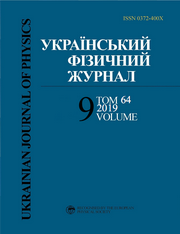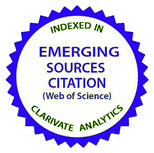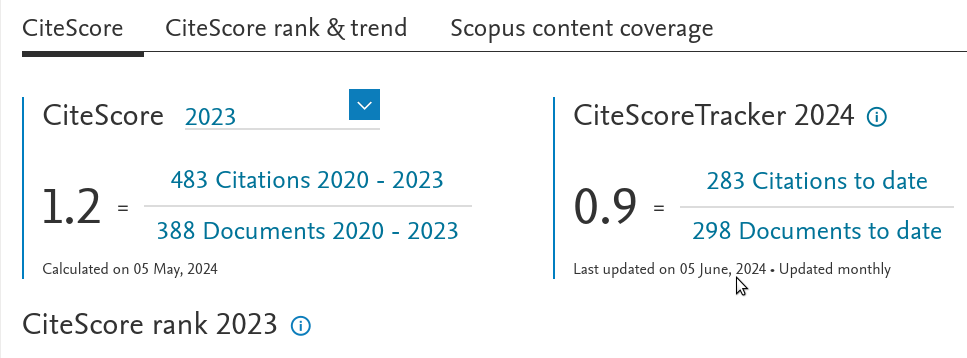Механізм збільшення потужності випромінювання газорозрядної лампи на сумішах парів дихлориду ртуті, неону та азоту в синьо-зеленому спектральному діапазоні
DOI:
https://doi.org/10.15407/ujpe64.9.803Ключові слова:
газорозрядна лампа, бар’єрний розряд, випромiнювання ексиплексних молекул, параметри плазми, дихлорид ртутi, азот, неонАнотація
Встановлено механiзм збiльшення потужностi випромiнювання газорозрядної лампи на сумiшах парiв дихлориду ртутi, азоту та неону в порiвняннi з сумiшшю парiв дихлориду ртутi i неону в синьо-зеленому спектральному дiапазонi. Встановлено оптичнi характеристики, параметри плазми, величину приведеного електричного поля, при якому питома потужнiсть розряду, що вноситься в збудження ексиплексних молекул монохлориду ртутi, максимальна. Результати дослiджень можуть бути використанi для створення бiльш ефективної ексиплексної лампи, що випромiнює спектральнi смуги в синьо-зеленому спектральному дiапазонi.
Посилання
J.H. Parks. Laser action on the B2Σ+1/2 → X2Σ+1/2 band of HgBr at 5018 ˚ A. Appl. Phys. Lett. 31, 297 (1977). https://doi.org/10.1063/1.89676
R. Burnliam. Discharge pumped mercuric halide dissociation lasers. Appl. Phys. Lett. 33, 152 (1978). https://doi.org/10.1063/1.90290
I.S. Lakoba, S.I. Yakovlenko. Active media of exciplex lasers (A review). Kvant. Elektron. 7, 677 (1980) (in Russian).
R. Burnham, E.J. Schimitschek. High-power blue-green lasers. Laser Focus 6, 54 (1981).
S.P. Bazhulin, N.G. Basov, S.N. Bugrimov, V.S. Zuev, A.S. Kamrukov, G.N. Kashnikov, N.P. Kozlov, P.A. Ovchinnikov, A.G. Opekan, V.K. Orlov, Yu.S. Protasov. Green-emitting mercury chloride laser pumped by wide-band optical radiation. Sov. J. Quant. Electron. 16, 836 (1986). https://doi.org/10.1070/QE1986v016n06ABEH006928
A.M. Boichenko, M.I. Lomaev, A.N. Panchenko et al. Ultraviolet and Vacuum-Ultraviolet Excilamps: Physics, Technology and Applications (STT, 2011) (in Russian).
A.N. Malinin. Excitation of mercury monohalides in the plasma of pulse-periodic discharge in mixtures of mercury dihalides and rare gases. Laser Phys. 7, 1032 (1997).
A.N. Malinin. The main characteristics of the plasma of pulse glow discharge in mixtures of mercury dihalides and rare gases. Laser Phys. 8, 395 (1998).
M.M. Guivan, O.M. Malinin, L.L. Shimon. Optimization of the component composition of gas-discharge HgBr-excimer lamps. Nauk. Visn. Uzhgorod. Univ. 4, 12 (1999) (in Ukrainian).
A.N. Malinin, N.N. Guivan, L.L. Shimon. Emission spectra of working mixtures of the HgBr/HgCl excimer lamp. Opt. Spektrosk. 89, 905 (2000) (in Russian). https://doi.org/10.1134/1.1335029
M.M. Guivan, O.M. Malinin, L.L. Shimon. Optimization of optical characteristics of working mixtures for HgBr and HgCl exilamps. Zh. Fiz. Dosl. 6, 74 (2002) (in Ukrainian).
M.M. Guivan, A.N. Malinin. Investigation of the process of excitation of mercury monobromide and monochloride excimer molecules in dense gas-discharge plasma. Ukr. J. Phys. 47, 24 (2002).
Yu.I. Posudin. Laser Photobiology (Vyshcha Shkola, 1989) (in Russian).
V.D. Romanenko, Yu. G. Krot, L.A. Syrenko, V.D. Solomatina. Biotechnology of Hydrobionts Cultivation (Inst. of Hydrobiology, Kyiv, 1999) (in Russian).
U. Kogelschatz. Fundamentals and Applications of Dielectric-barrier Discharges (ABB Corparate Research Ltd, 5405 Dfden, 2000).
T.E. Kuleshova, A.I. Likhachev, E.S. Pavlova et al. Interrelation between absorption spectra of plant pigments and LED illumination with various spectral compositions. Zh. Tekhn. Fiz. 88, 1285 (2018) (in Russian).
G.B. Popovych, A.O. Malinina, I.I. Aksenyuk, R.V. Grytsak. Influence of additional artificial illumination on the initial growth and development stages of tomato and cucumber seedlings. Ovochiv. Bashtann. 64, 44 (2018) (in Ukrainian). https://doi.org/10.32717/0131-0062-2018-64-44-49
G. Zissis, S. Kitsinelis. State of art on the science and technology of electrical light sources: from the past to the future. J. Phys. D 42, 173001 (2009). https://doi.org/10.1088/0022-3727/42/17/173001
U. Kogelschatz. Ultraviolet excimer radiation from none-quilibrium gas discharges and its application in photophysics, photochemistry and photobiology. J. Opt. Technol. 79, 484 (2012). https://doi.org/10.1364/JOT.79.000484
A.A.Malinina, A.K. Shuaibov, A.N.Malinin. Optical emission of atmospheric-pressure dielectric barrier discharge plasma on mercury diiodide/rare gases mixtures. IOSR J. Appl. Phys. 9, 51 (2017). https://doi.org/10.9790/4861-0901015157
V.B. Basov. LEDs: advantages and disadvantages. Elektro-Zh. 6, 34 (2010) (in Russian).
Properties of Inorganic Compounds. A Handbook. Edited by A.I. Efimov, L.P. Belorukova, I.V. Vasilkova, V.P. Chechev (Khimiya, 1983) (in Russian).
R.A. Sapozhnikov. Theoretical Photometry (Energiya, 1977) (in Russian).
R.W. Pears, A.G. Gaydon. The Identification of Molecular Spectra (Chapman and Hall, 1963).
Yu.S. Akishev, A.V. Dem'yanov, V.B. Karalnik et al. Pulsed regime of the diffusive mode of a barrier discharge in helium Fiz. Plazmy 27, 176 (2001) (in Russian). https://doi.org/10.1134/1.1348495
G.J.M. Hagelaar, L.C. Pitchford. Solving the Boltzmann equation to obtain electron transport coefficients and rate coefficients for fluid models. Plasma Sourc. Sci Technol. 14, 722 (2005). https://doi.org/10.1088/0963-0252/14/4/011
https://www.bolsig.laplace.univ-tlse.fr/.
V. Kushawaha, M.J. Mahmood. Electron impact dissociation of HgX2 (X = Cl, Br, I). Appl. Phys. 62, 2173 (1987). https://doi.org/10.1063/1.339518
A.N. Malinin. Excitation of the B2Σ+1/2 state of mercury monohalides by electron impact. Laser Phys. 7, 1177 (1997).
Yu.P. Raizer, Gas Discharge Physics (Springer, 1997).
A. Mandl, J.J. Parks, C. Roxlo. Collisional quenching kinetics for the HgCl* and HgBr* (B2Σ+1/2) state. J. Chem. Phys. 72, 504 (1980). https://doi.org/10.1063/1.438934
A.N. Malinin. The efficiency of the quenching of the B2Σ+1/2 state in mercury monohalides by halogen-containing molecules in active media of HgCl, HgBr, and HgJ excimer lasers. Laser Phys. 7, 1177 (1997).
W.R. Wadt. The electronic structure of HgCl2 and HgBr2 and its relationship to photodissociation. J. Chem. Phys. 72, 2469 (1980). https://doi.org/10.1063/1.439442
W.L. Nighan, R.T. Brown. Kinetic processes in the HgBr(B → X)/HgBr2 dissociation laser. J. Appl. Phys. 53, 7201 (1982). https://doi.org/10.1063/1.331616
W.R. Wadt. The electronic structure of HgCl and HgBr. Appl. Phys. Lett. 34, 658 (1979). https://doi.org/10.1063/1.90627
V.V. Datsyuk, I.A. Izmailov, V.A. Kochelap. Vibrational relaxation of excimer molecules. Usp. Fiz. Nauk 168, 439 (1998) (in Russian). https://doi.org/10.3367/UFNr.0168.199804c.0439
Applied Atomic Collision Physics. Vol. 3: Gas Lasers. Edited by E.W. McDaniel, W.L. Nighan (Academic Press, New York, 1982).
V.V. Datsyuk, I.A. Izmailov, V.V. Naumov, V.A. Kochelap. Direct electron-impact mechanism of excitation of mercury monobromide in a double-pulse dielectric-barrier-discharge HgBr lamp. Plasma Sourc. Sci. Technol. 25, 045020 (2016). https://doi.org/10.1088/0963-0252/25/4/045020
A.C. Erlandson, T.A. Cool. On the regeneration mechanism of HgBr/2 in HgBr/HgBr2 dissociation lasers. Chem. Phys. Lett. 96, 685 (1983). https://doi.org/10.1016/0009-2614(83)80074-8
Downloads
Опубліковано
Як цитувати
Номер
Розділ
Ліцензія
Ліцензійний Договір
на використання Твору
м. Київ, Україна
Відповідальний автор та співавтори (надалі іменовані як Автор(и)) статті, яку він (вони) подають до Українського фізичного журналу, (надалі іменована як Твір) з одного боку та Інститут теоретичної фізики імені М.М. Боголюбова НАН України в особі директора (надалі – Видавець) з іншого боку уклали даний Договір про таке:
1. Предмет договору.
Автор(и) надає(ють) Видавцю безоплатно невиключні права на використання Твору (наукового, технічного або іншого характеру) на умовах, визначених цим Договором.
2. Способи використання Твору.
2.1. Автор(и) надає(ють) Видавцю право на використання Твору таким чином:
2.1.1. Використовувати Твір шляхом його видання в Українському фізичному журналі (далі – Видання) мовою оригіналу та в перекладі на англійську (погоджений Автором(ами) і Видавцем примірник Твору, прийнятого до друку, є невід’ємною частиною Ліцензійного договору).
2.1.2. Переробляти, адаптувати або іншим чином змінювати Твір за погодженням з Автором(ами).
2.1.3. Перекладати Твір у випадку, коли Твір викладений іншою мовою, ніж мова, якою передбачена публікація у Виданні.
2.2. Якщо Автор(и) виявить(лять) бажання використовувати Твір в інший спосіб, як то публікувати перекладену версію Твору (окрім випадку, зазначеного в п. 2.1.3 цього Договору); розміщувати повністю або частково в мережі Інтернет; публікувати Твір в інших, у тому числі іноземних, виданнях; включати Твір як складову частину інших збірників, антологій, енциклопедій тощо, то Автор(и) мають отримати на це письмовий дозвіл від Видавця.
3. Територія використання.
Автор(и) надає(ють) Видавцю право на використання Твору способами, зазначеними у п.п. 2.1.1–2.1.3 цього Договору, на території України, а також право на розповсюдження Твору як невід’ємної складової частини Видання на території України та інших країн шляхом передплати, продажу та безоплатної передачі третій стороні.
4. Строк, на який надаються права.
4.1. Договір є чинним з дати підписання та діє протягом усього часу функціонування Видання.
5. Застереження.
5.1. Автор(и) заявляє(ють), що:
– він/вона є автором (співавтором) Твору;
– авторські права на даний Твір не передані іншій стороні;
– даний Твір не був раніше опублікований і не буде опублікований у будь-якому іншому виданні до публікації його Видавцем (див. також п. 2.2);
– Автор(и) не порушив(ли) права інтелектуальної власності інших осіб. Якщо у Творі наведені матеріали інших осіб за виключенням випадків цитування в обсязі, виправданому науковим, інформаційним або критичним характером Твору, використання таких матеріалів здійснене Автором(ами) з дотриманням норм міжнародного законодавства і законодавства України.
6. Реквізити і підписи сторін.
Видавець: Інститут теоретичної фізики імені М.М. Боголюбова НАН України.
Адреса: м. Київ, вул. Метрологічна 14-б.
Автор: Електронний підпис від імені та за погодження всіх співавторів.

















